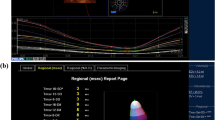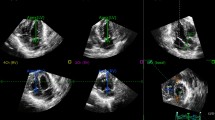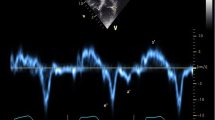Abstract
Assessment of ventricular dysfunction and asynchrony is very important in predicting the outcome for children with a single right ventricle. However, the assessment is inaccurate and subjective because of the unusual ventricular shape. This study aimed to evaluate the feasibility and clinical value of velocity vector imaging for assessing longitudinal systolic ventricular dysfunction and intraventricular asynchrony in children with a single right ventricle. The study enrolled 36 children with a single right ventricle and 36 age-matched children with a normal heart. Peak systolic velocity, peak displacement, strain, strain rate, time to peak systolic velocity, and time to peak systolic strain were measured via velocity vector imaging using the Siemens Sequoia C512 echocardiography instrument. The maximum positive rate of ventricular pressure change (Max [dp/dt]) was obtained by cardiac catheterization for all the children with a single right ventricle. In the children with a single right ventricle, the maximal temporal differences and the standard deviations of the times to peak systolic velocity and peak systolic strain were higher (P < 0.01) than in the children with a normal heart. Moreover, the strain and strain rate values were significantly lower in all six segments (P < 0.05). The strain rate of the basal segment adjacent to the rudimentary chamber correlated best with Max (dp/dt) (r = 0.86; P < 0.01). Longitudinal systolic dysfunction and intraventricular asynchrony could be assessed accurately using velocity vector imaging in children with a single right ventricle.


Similar content being viewed by others
References
Anconina J, Danchin N, Selton-Suty C et al (1992) Measurement of right ventricular dp/dt: a simultaneous/comparative hemodynamic and Doppler echocardiographic study. Arch Mal Coeur Vaiss 85:1317–1321
Bassareo PP, Tumbarello R, Piras A et al (2010) Evaluation of regional myocardial function by Doppler tissue imaging in univentricular heart after successful Fontan repair. Echocardiography 27:702–708
Batra AS, Balaji S (2009) Cardiac resynchronization therapy in children. Curr Cardiol Rev 5:40–44
Becker AE, Anderson RH (1986) Pathology of congenital heart disease. Butterworths, London, pp 241–244
Chen J, Cao T, Duan Y et al (2007) Velocity vector imaging in assessing the regional systolic function of patients with post myocardial infarction. Echocardiography 24:940–945
Claus P, Weidemann F, Dommke C et al (2007) Mechanisms of postsystolic thickening in ischemic myocardium: mathematical modelling and comparison with experimental ischemic substrates. Ultrasound Med Biol 33:1963–1970
Demirkol S, Unlü M, Arslan Z et al (2013) Assessment of right ventricular systolic function with dp/dt in healthy subjects: an observational study. Anadolu Kardiyol Derg 13:103–107
D’Udekem Y, Xu MY, Galati JC et al (2012) Predictors of survival after single-ventricle palliation: the impact of right ventricular dominance. J Am Coll Cardiol 59:1178–1185
Eyskens B, Ganame J, Claus P et al (2006) Ultrasonic strain rate and strain imaging of the right ventricle in children before and after percutaneous closure of an atrial septal defect. J Am Soc Echocardiogr 19:994–1000
Fontana A, Zambon A, Cesana F et al (2012) Tissue Doppler, triplane echocardiography, and speckle-tracking echocardiography: different ways of measuring longitudinal myocardial velocity and deformation parameters: a comparative clinical study. Echocardiography 29:428–437
Friedberg MK, Silverman NH, Dubin AM et al (2007) Right ventricular mechanical dyssynchrony in children with hypoplastic left heart syndrome. J Am Soc Echocardiogr 20:1073–1079
Hayat D, Kloeckner M, Nahum J et al (2012) Comparison of real-time three-dimensional speckle tracking to magnetic resonance imaging in patients with coronary heart disease. Am J Cardiol 109:180–186
Ho PK, Lai CT, Wong SJ et al (2012) Three-dimensional mechanical dyssynchrony and myocardial deformation of the left ventricle in patients with tricuspid atresia after Fontan procedure. J Am Soc Echocardiogr 25:393–400
Knirsch W, Dodge-Khatami A, Kadner A et al (2008) Assessment of myocardial function in pediatric patients with operated tetralogy of Fallot: preliminary results with 2D strain echocardiography. Pediatr Cardiol 29:718–725
Kurotobi S, Sano T, Naito H et al (1998) Regional ventricular systolic abnormalities caused by a rudimentary chamber in patients with univentricular hearts. Am J Cardiol 82:86–92
Lai WW, Geva T, Shirali GS et al (2006) Guidelines and standards for performance of a pediatric echocardiogram: a report from the Task Force of the Pediatric Council of the American Society of Echocardiography. J Am Soc Echocardiogr 19:1413–1430
Menon SC, Gray R, Tani LY (2011) Evaluation of ventricular filling pressures and ventricular function by Doppler echocardiography in patients with functional single ventricle: correlation with simultaneous cardiac catheterization. J Am Soc Echocardiogr 24:1220–1225
Moiduddin N, Texter KM, Zaidi AN et al (2010) Two-dimensional speckle strain and dyssynchrony in single right ventricles versus normal right ventricles. J Am Soc Echocardiogr 23:673–679
Moiduddin N, Texter KM, Zaidi AN et al (2010) Two-dimensional speckle strain and dyssynchrony in single left ventricles vs normal left ventricles. Congenit Heart Dis 5:579–586
Petko C, Hoffmann U, Möller P et al (2010) Assessment of ventricular function and dyssynchrony before and after stage 2 palliation of hypoplastic left heart syndrome using two-dimensional speckle tracking. Pediatr Cardiol 31:1037–1042
Singh GK, Cupps B, Pasque M et al (2010) Accuracy and reproducibility of strain by speckle tracking in pediatric subjects with normal heart and single ventricular physiology: a two-dimensional speckle-tracking echocardiography and magnetic resonance imaging correlative study. J Am Soc Echocardiogr 23:1143–1152
Sivesgaard K, Christensen SD, Nygaard H et al (2009) Speckle-tracking ultrasound is independent of insonation angle and gain: an in vitro investigation of agreement with sonomicrometry. J Am Soc Echocardiogr 22:852–858
Soriano BD, Hoch M, Ithuralde A et al (2008) Matrix-array 3-dimensional echocardiographic assessment of volumes, mass, and ejection fraction in young pediatric patients with a functional single ventricle: a comparison study with cardiac magnetic resonance. Circulation 117:1842–1848
Utsunomiya H, Nakatani S, Okada T et al (2011) A simple method to predict impaired right ventricular performance and disease severity in chronic pulmonary hypertension using strain rate imaging. Int J Cardiol 147:88–94
Weidemann F, Eyskens B, Jamal F et al (2002) Quantification of regional left and right ventricular radial and longitudinal function in healthy children using ultrasound-based strain rate and strain imaging. J Am Soc Echocardiogr 15:20–28
Zhang YQ, Sun K, Zhu SL et al (2008) Doppler myocardial performance index in assessment of ventricular function in children with single ventricles. World J Pediatr 4:109–113
Acknowledgments
We are indebted to all the staff of the Catheterization Laboratory at Shanghai Children’s Medical Center for their support. This study was supported by programs from the Shanghai Science and Technology Commission (10411965300) and the Innovation Program of the Shanghai Municipal Education Commission (13ZZ081).
Author information
Authors and Affiliations
Corresponding author
Rights and permissions
About this article
Cite this article
Wu, YR., Zhang, YQ., Chen, LJ. et al. Assessment of Longitudinal Systolic Ventricular Dysfunction and Asynchrony Using Velocity Vector Imaging in Children With a Single Right Ventricle. Pediatr Cardiol 35, 1147–1154 (2014). https://doi.org/10.1007/s00246-014-0908-4
Received:
Accepted:
Published:
Issue Date:
DOI: https://doi.org/10.1007/s00246-014-0908-4




